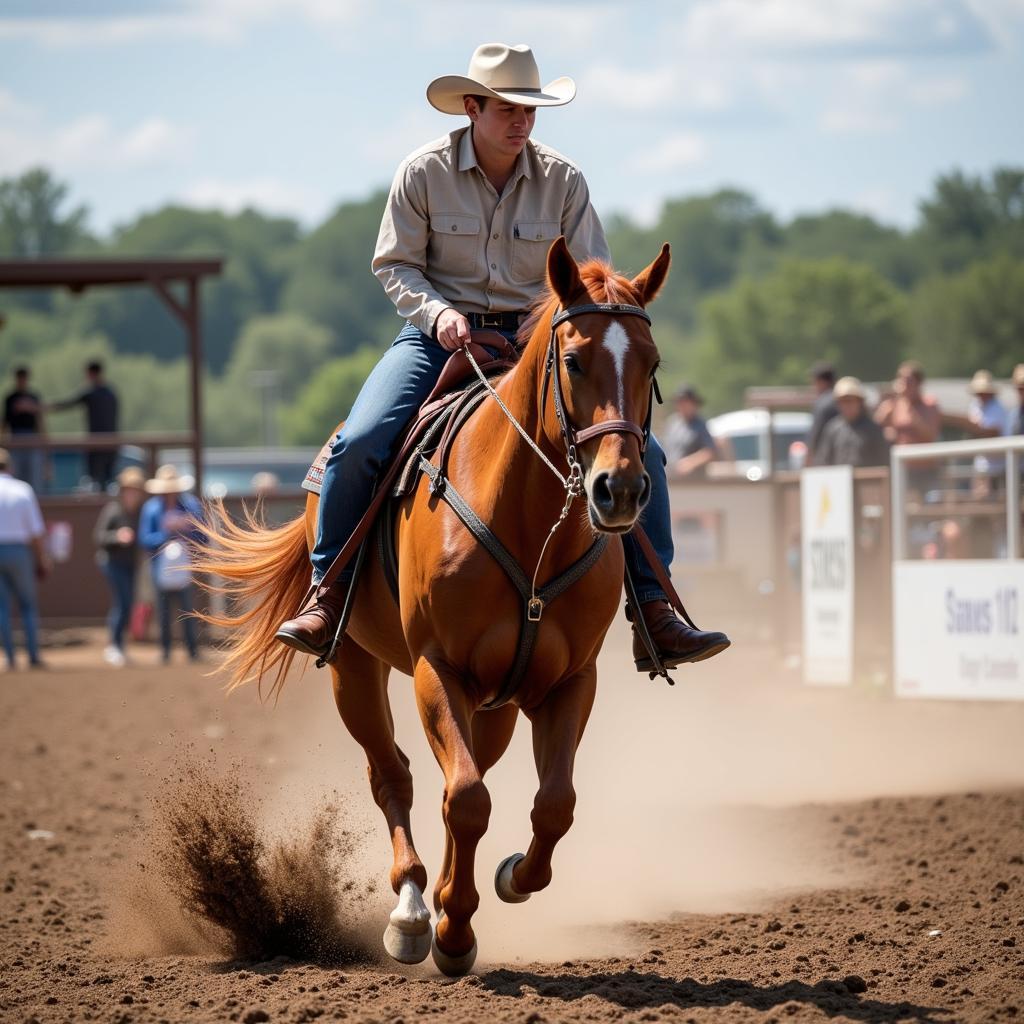The Quarter Horse Chestnut coat color is a captivating variation within this versatile breed. This guide delves into the genetics, care, and unique characteristics of these stunning horses, providing valuable insights for horse enthusiasts. Let’s explore the world of the quarter horse chestnut and discover what makes them so special.
Understanding the Chestnut Coat in Quarter Horses
Chestnut is one of the most common coat colors in quarter horses, characterized by a rich, reddish-brown hue that ranges from a light sorrel to a deep liver chestnut. Genetically, the chestnut coat results from the presence of two recessive red alleles (ee). This distinctive color often gives the quarter horse chestnut a striking appearance. Did you know that the shade of chestnut can be influenced by other genes, leading to variations like flaxen chestnut or red dun? These variations add to the diversity and beauty within the quarter horse chestnut population. What aspects of caring for a chestnut quarter horse are unique to their coat color?
Caring for Your Quarter Horse Chestnut
Caring for a quarter horse black stallion or a chestnut variation requires diligence and attention to detail. Just like any quarter horse, regular grooming is essential to maintain a healthy coat and prevent skin issues. What makes chestnut coats special is their tendency to fade in sunlight. Regular grooming and the use of coat conditioners can help protect the coat and maintain its vibrant color. Proper nutrition also plays a crucial role in coat health, ensuring a glossy and vibrant appearance. A balanced diet rich in vitamins and minerals contributes to the overall well-being of your quarter horse chestnut.
Protecting Your Chestnut Coat from Sun Damage
Chestnut coats are particularly susceptible to sun bleaching. What steps can you take to protect your quarter horse chestnut’s beautiful coat from the sun’s harmful rays? Using fly sheets and offering shaded areas in the pasture can significantly minimize sun exposure. Additionally, specialized shampoos and conditioners formulated for chestnut coats can help protect against fading and enhance the natural reddish-brown hues.
Quarter Horse Chestnut: Conformation and Performance
The chestnut coat color doesn’t influence the conformation or performance of a quarter horse. Their athleticism, versatility, and calm temperament are characteristics of the breed, regardless of coat color. Quarter horse chestnuts excel in various disciplines, from western riding and barrel racing to young horse show series and even English disciplines.
Chestnut Quarter Horses in Competition
Chestnut quarter horses are a common sight in competitions across various disciplines. They’re highly sought after for their athleticism and trainability. Are you interested in showing your quartz horse? Check out our guide to the london 52 horse show series.
 A chestnut quarter horse and rider competing in a western riding event, demonstrating the horse's agility and the rider's skill.
A chestnut quarter horse and rider competing in a western riding event, demonstrating the horse's agility and the rider's skill.
The Allure of the Chestnut Coat
The rich, warm tones of the chestnut coat have captivated horse lovers for centuries. What is it about this color that makes it so appealing? Perhaps it’s the association with strength and vitality, or maybe it’s simply the aesthetic appeal of the vibrant reddish-brown hues against the horse’s muscular physique. Regardless of the reason, the chestnut coat remains a popular choice among quarter horse enthusiasts.
“The chestnut coat on a quarter horse is simply breathtaking. It’s a color that truly embodies the spirit and energy of this remarkable breed.” – Dr. Amelia Hartman, Equine Veterinarian.
Conclusion
The quarter horse chestnut is a beautiful and versatile animal, prized for its athleticism, temperament, and striking coat color. Understanding the genetics, care, and unique characteristics of this coat color can help you appreciate and care for your quarter horse chestnut to the fullest. From protecting their coat from sun damage to ensuring proper nutrition, your dedication will contribute to their overall health and well-being. Whether you’re a seasoned horse owner or just starting your journey, the quarter horse chestnut is a breed that will undoubtedly leave a lasting impression.
FAQs
- What causes the chestnut coat color in quarter horses?
- How can I protect my chestnut quarter horse’s coat from sun damage?
- Are chestnut quarter horses suitable for beginners?
- What disciplines do chestnut quarter horses excel in?
- Are there different shades of chestnut in quarter horses?
- Do breyer horses classics come in chestnut variations?
- What are some common health concerns for chestnut quarter horses?
Common Scenarios and Questions
Scenario: My chestnut quarter horse’s coat has started to fade. What can I do?
Answer: Increased shade, specialized shampoos and conditioners, and a balanced diet can help restore and protect your horse’s coat.
Scenario: I’m looking for a versatile horse for both western and English riding. Is a chestnut quarter horse a good choice?
Answer: Absolutely! Quarter horses, regardless of coat color, are known for their versatility and excel in a wide range of disciplines.
Further Exploration
Explore these related topics on our website:
- Quarter Horse Coat Colors and Genetics
- Quarter Horse Care and Management
- Choosing the Right Quarter Horse for You
Need assistance? Contact us at Phone: 0772127271, Email: [email protected] or visit us at QGM2+WX2, Vị Trung, Vị Thuỷ, Hậu Giang, Việt Nam. Our customer support team is available 24/7.